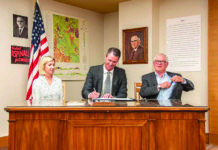Whether you need a bite to eat, need a new MAVcard, or have a question for any of the plentiful Student Life organizations, The University Center (UC) is every student and staff’s one-stop destination.
The UC serves as the primary hub for every Maverick at Colorado Mesa University (CMU), though little is known about its vast and unique history. Since its construction in 1962, the UC has undergone many remodels–even a complete demolition and reconstruction.
During the majority of CMU’s time as a junior college, however, there was no UC. Consequently, many services typical of the building, including a bookstore, were located in on-campus barracks provided by the government during World War II.
“In the post-war period, because Mesa had done some work for the defense program and things like that, the Army gave us barracks, basically army housing,” Special Collections & Archives librarian Amber D’Ambrosio said. “And so that was in part used to house student veterans, but then it also over the years became other things, like classrooms and the bookstore. It was kind of filling the purpose of a University Center, just because there wasn’t space anywhere else for those things.”
Shortly after the construction of Wubben Hall & Science Center, CMU’s third building, then-President Horace Wubben began construction of the first official UC. At the end of its construction, it was dubbed the College Center and remained so for decades.
“…A lot of [the buildings constructed in the 60s] had a very similar, very low profile. [They were] brick buildings–like a single story, kind of flat-looking. And so that was the College Center for 20 years,” D’Ambrosio said. “It’s really interesting because the University Center is really the only building that’s been replaced wholesale over the years; a lot of the buildings on campus either were torn down and never replaced, or they’ve been added on to.”
Though the UC was eventually demolished and reconstructed, the building underwent drastic remodels in the 80s. To accommodate the recent addition of baccalaureate programs in 1974 and the steady growth of the campus, the College Center was expanded and renamed the W.W. Campbell Center.
The W.W. Campbell Center’s expansion and 80s remodel led to the creation of a unique appearance aptly referred to as a “Franken-Building” by D’Ambrosio. While the building’s annexations were lost to reconstruction in 2010, its green-thumb decor should be remembered for some time.
“When they first [expanded on the UC] there were plants everywhere,” D’Ambrosio said. “Just lots and lots of wood paneling and plants. I’m not quite sure why that was an aesthetic for the 80s but it was.”
Under ex-President Tim Foster’s endeavors to modernize CMU in the early 2000s, the W.W. Campbell Center was demolished in its entirety. After its reconstruction in 2009-2010, what is now known as the UC came to be.
Aside from its notable lack of plants, the current version of the UC comprises a much more modern design and increased space than its previous iterations. One of the major boasts of the current UC is its event space, including the Meyer Ballroom.
“I think [the UC] was envisioned as being more of a hub, or an area to be able to come in and hold events there, as well as holding university events there,” D’Ambrosio said. “And I think that’s probably one of the things that make it stand out from the previous versions.”
Considering that the UC is one of the most recognized and visited buildings on campus today, the center we have come to know and love now has come a long way. From its origins inside student barracks to its original version as a junior college center and even as a pseudo-forest, the UC certainly boasts one fascinating history.




